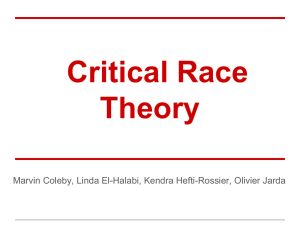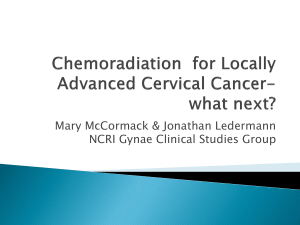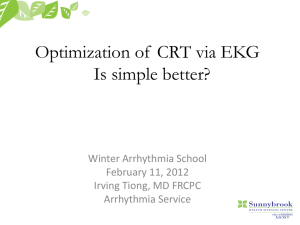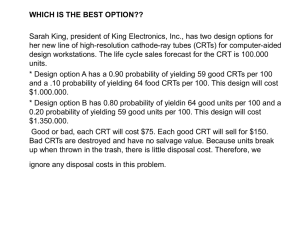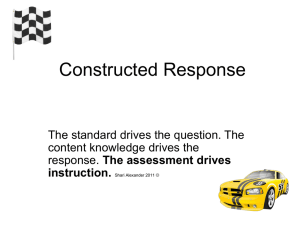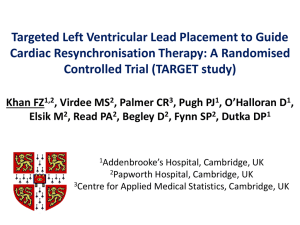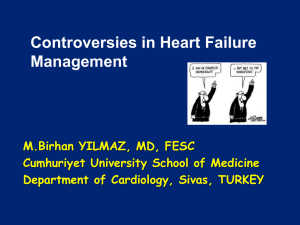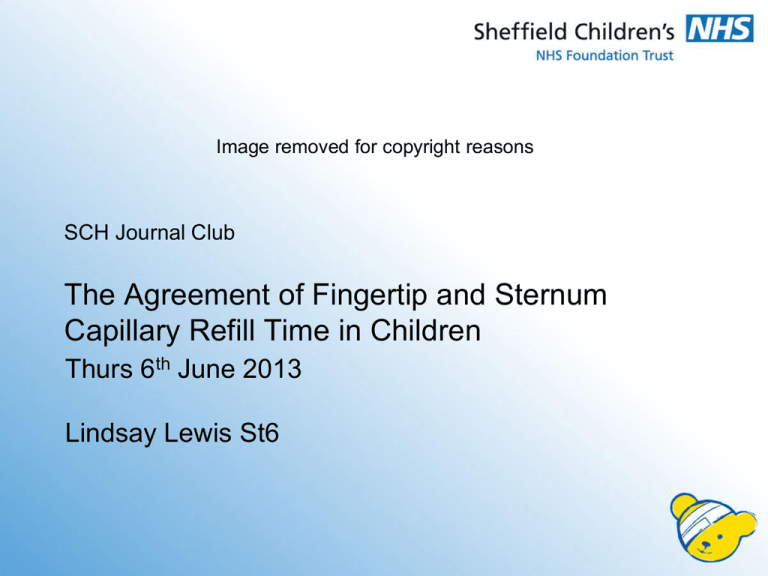
Image removed for copyright reasons
SCH Journal Club
The Agreement of Fingertip and Sternum
Capillary Refill Time in Children
Thurs 6th June 2013
Lindsay Lewis St6
Aim
To determine the agreement of fingertip and sternum CRT
in children
Objectives
• Search literature relevant to question
• Select useful paper to discuss
• Determine validity and reliability of paper in answering
question
• Assess whether clinical practice needs to change
Background
• CRT 1st used in battlefields in 1940s
• Champion et al arbitrarily chose upper limit of 2 sec,
used as part of scoring system
• Limited research in its use in children (particularly
sternal)
• Research in neonates shown that length of pressure and
degree of pressure affect CRT
Current Practice
•
•
•
•
•
•
CRT used as part of assessment in all ill children
ALSG and NICE guidelines
Normal < 2 sec
Must press for 5 sec
Central (sternum) OR peripheral (finger tip)
Used interchangeably but should they?
Clinical Question
Population
Paediatric (< 18yrs)
Intervention
Performing central CRT
Comparison
Performing peripheral
CRT
Time / duration of CRT
Outcome
Design
Observational
(Prospective, methodcomparison study)
Literature Search
• CRT AND Central and / or peripheral
• Limited to children (<16yrs)
• Searches; medline, embase, cochrane
The agreement of fingertip and
sternum capillary refill time in
children
Jodie Crook , Rachel M Taylor
Archives of Diseases in Childhood Online First Feb 9th 2013
Doi:10.1136/archdichild-2012-303046
Methods 1
•
•
•
•
•
•
Written consent & ethical approval
Single paediatric A+E dept in UK
March 2011
Well children
1month – 12 years
Exclusion criteria; medication, distressed, D+V, poor
intake, cardiac / IEM
Methods 2
•
•
•
•
•
•
One observer
Same room / lighting
Temperature controlled in waiting and triage room
CRT measured after 30min
Standard technique
Timed in milliseconds using digital SW
Methods 3 / Outcome measures
• Difference of 0.5s taken to be clinically significant
• Data analysed using two-tailed t test
• Pearson’s correlation coefficient used to measure
relationship
• Bland Altman used to determine agreement
1524 children in A+E
1421 not approached
103 eligible approached
100 consented
8 excluded
92 studied
3 refused
Results
•
•
•
•
48 female (52%)
44 male (48%)
Mean age 6.3 years 3.7
Ethnic groups;
- white (n=37)
- asian (n=36%)
- mixed race (n=19)
- black (n=3)
Reason for attendance to A&E
Reason for
attendance
n (%)
Diagnosis
N (%)
Minor injury
53 (58)
46 (50)
Head injury
17 (18)
17 (18)
NAD
0 (0)
8 (9)
Foreign body
7 (8)
4 (4)
Rash
4 (4)
0 (0)
Viral illness
3 (3)
4 (4)
Burn/scald
2 (2)
2 (2)
Miscellaneous
6 (7)
11 (12)
Clinical Observations
Mean
Range
Heart rate (beats
per minute)
99±18.8
67–146
Respiratory rate
(breaths per
minute)
21.6±3.9
15–36
Temperature (°C)
36.9±0.3
36.2–37.5
Oxygen
saturation (%)
99±0.97.
97–100
CRT—fingertip (s) 1.08±0.44
0.05–2.78
CRT—Sternum
(s)
0.85–2.38
1.5±0.33
Results
• Fingertip CRT on average 0.42s quicker than sternum
CRT
• Statistically significant difference between fingertip and
sternum CRT (p<0.001)
• Weak relationship between the two
• Fingertip CRT showed greater variability
Pearson's correlation coefficient test demonstrated a weak relationship between fingertip and
sternum capillary refill time (CRT) (r=0.18, p>0.05).
Crook J , and Taylor R M Arch Dis Child 2013;98:265-268
Copyright © BMJ Publishing Group Ltd & Royal College of Paediatrics and Child Health. All rights reserved.
The Bland Altman comparison showed the mean difference between fingertip and sternum
capillary refill time (CRT) was −0.49±0.51 with an upper and lower limit of agreement ranging
from −1.5 to 0.53, indicating sternum CRT ranged between 1.5 s slower to 0.53 s quicker than
fingertip CRT—upper and lower limits of agreement.
Crook J , and Taylor R M Arch Dis Child 2013;98:265-268
Copyright © BMJ Publishing Group Ltd & Royal College of Paediatrics and Child Health. All rights reserved.
Lets Critique
• Are the results of the study valid?
•What are the results?
•Will the results help locally?
www.casp-uk.net/
Critique - Validity
1. Did the study address a clearly focused issue? Yes
2. Did the authors use an appropriate method to answer
their question? Yes
3. Were the patients recruited in an acceptable way? No
4. Was the outcome accurately measured to minimize
bias? Yes
5. Have the authors identified all important confounding
factors? Yes
Critique - Results
• What are the results of this study?
- Fingertip CRT on average 0.42 s quicker than sternum
- Weak association between measurements of CRT taken at the
fingertip and sternum
- Fingertip CRT shows greater variability than sternum CRT
• How precise are the results?
- Precise
• Do you believe the results?
- Yes
Critique - Usefulness
• Will the results help me locally? To some extent
• Do the results of this study fit with other
available evidence? Yes
Limitations
•
•
•
•
•
Small number
One A&E setting
Well children
Difference statistically significant but not clinically
Excluded dark skin
Summary and Conclusion
• Fingertip CRT on average 0.42 s quicker than
sternum CRT
• Difference is statistically significant
• However, not clinically significant
• Measurements of CRT taken at the fingertip and
sternum are not comparable in ‘well’ children
• More research needed!
Box 1 Five point recommendation for carrying out the capillary
refill time test
•Consider any factors that are likely to alter capillary refill time (CRT)
(eg, consider not doing CRT if coldness of poor lighting has the
potential to effect the result).
•Choose either the sternum or the fingertip pulp site (consider skin
colour and size of child's finger).
•Using your index finger apply enough pressure to cause the skin to
blanche (turn pale).
•Apply pressure for 5 s.
•Remove pressure and immediately count aloud how long it takes for
skin to return from blanched back to pretest colour.
CRT Should be 2–3 s
•One person should carry out CRT and it should not be repeated or
sites compared.
•When recording CRT in the patients notes the letter F or S should be
written next to the number to indicate whether the CRT was taken at
the fingertip pulp or sternum, respectively.
•Fingertip CRT requires raising the hand to heart level.

